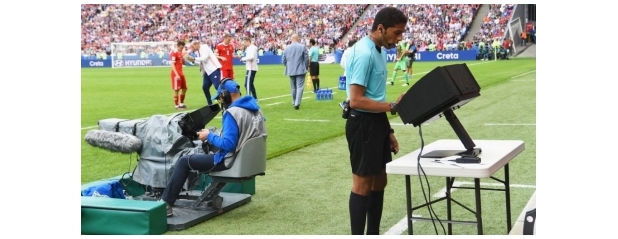How technology is changing the 2018 World Cup

The 2018 FIFA World Cup in Russia has seen a huge transformation thanks to innovative technology being put to work in ways football has never seen before. There are a number of tools that operate in the background to provide extra support and information to the referees and other teams on their decisions. So, could the World Cup results potentially be decided by a computer? Below are just a few technologies that will or already have had a big effect on matches in this World Cup.
VAR
VAR, also known as Video Assistant Referee is pretty self-explanatory. It is simply a video technology system designed to help the on-field referee make the right call on a decision that could change the result of the game. It’s always hard to make decisions when you’ve got to keep an eye on all the players on the pitch.
How does VAR work? Four off pitch referees sit in a video operation room and follow the live action on the screens. There are thirty three different cameras, plus two offside cameras which gives them all the angles they need to make the final decision. The on pitch referee can then communicate with the four in the video room via microphone.
VAR was first trialled in England during the FA Cup this season and the 2018 World Cup is the first major international football tournament to use the system. The first game to have seen a major VAR decision was the France vs Australia where France earned a penalty thanks to VAR footage.
Goal Line Technology
As well as VAR, there is also the use of goal line technology that has been used for a number of years now. This is simply an electronic aid used to determine whether a goal has been scored or not. There are 14 high-speed cameras that send a signal within 1 second to the referee’s watch to confirm if the ball has crossed the line.
Electronic Performance & Tracking System
Another major technology that has been used in the 2018 World Cup is an Electronic Performance & Tracking System. This system consists of a number of tools and communication equipment for both teams. The tools include two optical tracking cameras that track the players and ball. This information is then sent to the analysts in real time alongside the live footage from the cameras. This information allows for real-time interaction that can feed into their decisions during the match.
Wearables
What exactly will the referees, players and managers be sporting in terms of wearable tech? We’ve already mentioned the VAR information being sent via microphone to the referee. As well as the watch they use for goal line technology. The watch can also provide the referees with data off the pitch such as information about other matches (timings, results, yellow cards etc.). These watches are provided by Hublot and are estimated to cost around £3,750 per watch.
Some teams have been wearing a PlayerTek smart vest which allows backroom staff to cross-examine player data more than ever. As well performance data, the vest allows you to record the distance covered in a match, where they travelled and how often they would sprint during a match.
Another wearable device is the Electronic Performance & Tracking Systems. These tracking devices can be embedded into the players shirts allowing the management team to track all kinds of activity throughout the match sent to them via tablet (only 3 tablets allowed per team). This device aims to limit overexertion and reduce risk of injury throughout the tournament.
As well as all of the above, let’s not forget about all the technology equipment needed to film all 64 matches at the 2018 World Cup. Approximately 1 billion people are expected to watch the Russia World Cup final in 2018 so you can image how much preparation has gone into making sure nothing interrupts the viewing experience.
There are 370 Sony cameras shooting the action, 8 of which are filming in UHD/4K format. A further 8 cameras are set up purely to capture footage in slow motion and then two in ultra-motion.
Some people say that all this technology is harming football by slowing the game down (sometimes taking over 2 minutes to receive a result from VAR) and even making it boring. However, others may say technology is saving football by ensuring all legitimate goals are counted (e.g. Frank Lampard’s disallowed goal in the 2010 World Cup) and illegitimate goals are not counted (e.g. Maradona’s ‘Hand of God’ goal in the 1986 World Cup).
